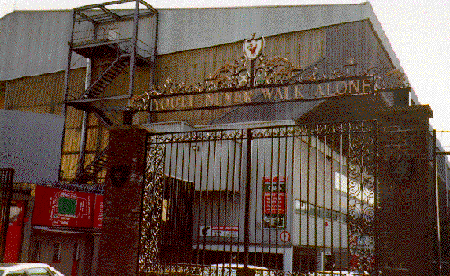ANFIELD HISTORYAfter a highly successful season in the Lancashire League, Liverpool were admitted to the Football League, and their first league game at Anfield was played on 9 September, 1893. They defeated Lincoln City by four goals to nil in front of 5,000 spectators. As the crowds began to flock to Anfield the club built a new stand in 1895 capable of seating 3,000. It was constructed on the site of the present Main Stand and remained until 1973, although many changes were made to it over the years. Another stand was built at the Anfield Road end in 1903, constructed from timber and corrugated iron. After Liverpool had won their second League Championship in 1906 the directors rewarded the fans by building a new banking at the Walton Breck Road. A local journalist, Ernest Edwards, of the Liverpool Daily Post and Echo christened it the Spion Kop, after a famous hill in South Africa where a local regiment had suffered heavy losses during the Boer War. The ground remained much the same for the next twenty years until 1928 when a major redevelopment occurred. The Kop was redesigned and extended to accommodate 30,000 with a huge roof erected. It was without question the largest Kop in the country, able to hold more supporters than some entire football grounds. The top mast of the Great Eastern, one of the first iron ships, was rescued from the breakers' yard at the Rock Ferry and was painstakingly hauled up the Everton Valley by a team of horses to be erected alongside the new Kop where it stood for many years. In 1957 floodlights were installed and on 30 October switched on for a game against neighbours Everton for a special trophy to commemorate the 75th anniversary of the Liverpool County FA. But there were other changes around Anfield until the team forced its way back into the First Division. In 1963, the old Kemlyn Road stand was replaced by a cantilevered stand, seating 6,700 and built at a cost of £350,000. A couple of years later alterations were made at the Anfield Road end, turning it into a large covered standing area. But the biggest redevelopment came in 1973 when the old Main Stand was ripped down and a magnificent new one constructed. It was officially opened on 10 March, 1973 by the Duke of Kent. The next major change came in the early 1990s when a second tier, costing £10 million, was added to the old Kemlyn Road stand, turning it into a magnificent 11,000 all-seater stand. The new stand was equipped with executive boxes, dinning boxes and bars, making it one of the finest stands in the country. In May 1994 came the most dramatic change of all, with the old Spion Kop torn down to be replaced by an all-seater stand, built to comply with the recommendations of the Taylor Report following the Hillsborough disaster. It was a sad day for Liverpool when they played their final match in front of a noisy flag-waving Kop, knowing that it would never be quite the same again. The times when 27,000 sang and swayed on those great European nights were gone forever. But in its place the club did the fans justice with a new 10,000 all-seater stand that brought the ground's capacity up to 40,000. All these changes in recent years have led to a fall in crowd capacity of Anfield. The record attendance of 61,905 to see Wolverhampton Wanders, then one of the outstanding teams of the day, play Liverpool in a fourth round FA Cup game in February 1952 will now stand forever. Liverpool's biggest victory at Anfield was in the European Cup Winners Cup when they beat Stromgodset 11-0 on 17 September 1974 while their biggest home defeat came in April 1930 when Sunderland beat them 6-0. Anfield has hosted six internationals, the first in 1889 when England beat Ireland by six goals to one. England have also played Wales there on three ocasions, in 1905, 1922 and 1931, winning all three games. In 1926 Ireland forced a memorable draw against England but perhaps the finest international to have graced Anfield was the World Cup game between Wales and Scotland in October 1977 when 50,000 saw Scotland win 2-0 to capture a place in the finals. During the Second World War England and Wales fought out a 2-2 draw in front of 38,000. Two features added to the ground in recent years reflect the strong bond between the club, its supporters and the players. Following the death of Bill Shankly, the club erected a memorial to him in the form of the Shankly Gates which were formally opened by his widow, Nessie. 'You'll Never Walk Alone' is the message which tops the fine wrought-iron gates. And after the Hillsborough tragedy when 96 died, a memorial was erected close by with an eternal flame. Alongside it are the names of all those who died. The many thousands who visited Anfield following the disaster will never forget the sight of thousands of scarves and flowers covering the pitch and the Kop, or hanging from the Shankly Gates in tribute. It was the supporters' own way of remembering.  |
